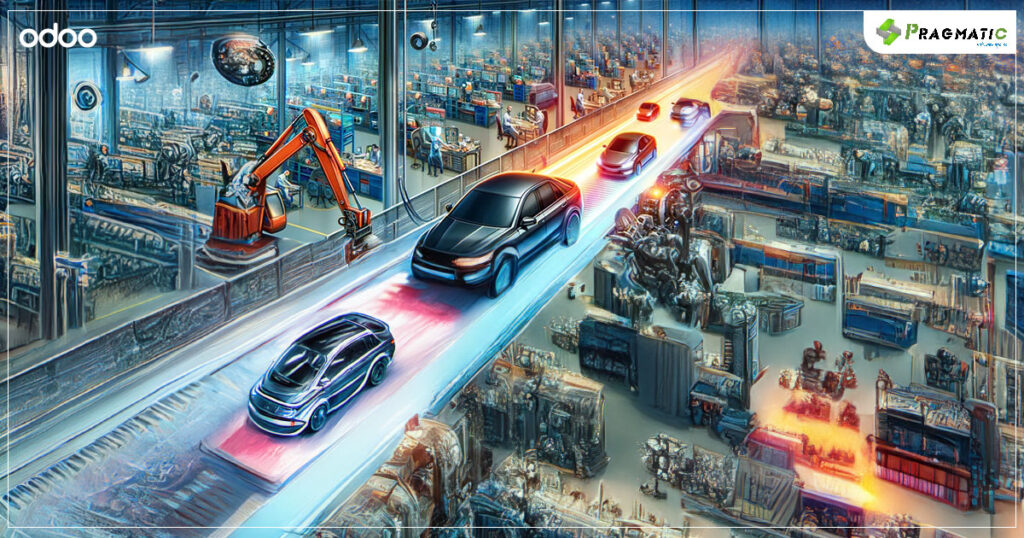

The automobile industry is a complex ecosystem, where countless parts come together on a tight production schedule. Managing this intricate web of suppliers, parts and assembly lines is crucial for success.
Odoo supply chain management, a powerful tool that can empower automakers to streamline every step, from parts procurement to final assembly.
This blog dives deep into how Odoo acts as the perfect pit crew for your automotive supply chain, boosting visibility, optimizing procurement and ultimately driving efficiency.
Imagine a world where ordering parts is a breeze and delays are a thing of the past. Odoo makes this a reality with its robust procurement functionalities. Here’s how :

1) Centralized Vendor Management : Consolidate your entire supplier network into a single platform. Odoo allows you to manage vendor information, track performance and automate purchase orders, saving valuable time and resources.
2) Bill of Materials (BoM) Management : Define the exact components needed for each vehicle model with ease. Odoo’s BoM feature helps you generate automatic purchase requisitions based on production plans, ensuring you have the right parts at the right time.
3) Inventory Optimization : Say goodbye to stockouts and excess inventory. Odoo’s intelligent inventory management system provides real-time visibility into stock levels, allowing you to set minimum reorder points and optimize ordering cycles.
4) Multi-Level MRP (Material Requirements Planning) : Plan ahead for every stage of production. Odoo’s MRP module takes into account lead times and production schedules to automatically generate purchase orders for all the components needed for finished vehicles.
According to a McKinsey & Company report, automotive manufacturers can achieve significant cost reductions (up to 15-20%) by optimizing their procurement processes. Odoo’s features empower you to do just that, streamlining parts acquisition and reducing reliance on emergency orders.
Having a clear view of your entire supply chain is paramount in automotive manufacturing industry, Odoo provides the tools you need to achieve this :
Companies with high levels of supply chain visibility are better equipped to handle disruptions and maintain operational continuity.
With Odoo, you gain the power to see the big picture, anticipate challenges and ensure a smooth flow of parts throughout your production process.
Here’s a closer look, along with some insights on how Odoo optimizes each step :
1. Demand Forecasting & Bill of Materials (BoM) Creation
Car manufacturers forecast vehicle sales based on market trends and pre-orders. This data feeds into the creation of a Bill of Materials (BoM) for each vehicle model. The BoM is a detailed list of all the parts required to build a single car, along with their quantities.
Odoo integrates seamlessly with sales and forecasting tools, allowing you to import sales data and generate BoMs automatically. This eliminates manual data entry errors and ensures your BoMs are always up-to-date.
2. Supplier Selection & Negotiation
With the BoM in hand, the procurement team identifies qualified suppliers for each component. This involves evaluating factors like price, quality, lead times and past performance. Negotiations are conducted to secure the best possible terms.
Odoo’s vendor management module helps you centralize supplier information, track performance metrics, and automate communication. You can compare quotes from different suppliers side-by-side to make informed decisions.
3. Purchase Order Generation & Inventory Management
Once suppliers are selected, purchase orders (POs) are generated for each component based on the BoM and production schedule. Effective inventory management ensures you have the right parts in stock at the right time, avoiding production delays.
Odoo’s MRP (Material Requirements Planning) module automatically generates POs based on lead times and production plans. Real-time inventory dashboards provide instant insights into stock levels, allowing you to set minimum reorder points and optimize ordering cycles.
4. Receiving & Quality Control
As parts arrive from suppliers, they are inspected for quality and conformance to specifications. Any discrepancies are documented and parts may be rejected if they don’t meet quality standards.
Odoo can be integrated with barcode scanners and other warehouse management tools to streamline the receiving process. Quality control checklists can be created within the system to ensure all parts meet specifications.
5. Just-in-Time (JIT) Inventory & Production Scheduling
Ideally, parts arrive at the assembly line “just-in-time” to be used, minimizing storage requirements and carrying costs. Production scheduling dictates the order and timing of vehicle assembly, ensuring a smooth flow of parts to the line.
Odoo’s functionalities support a JIT approach by providing real-time visibility into inventory levels and supplier lead times. Production schedules can be dynamically adjusted based on actual inventory data, minimizing the risk of stockouts.
6. Assembly & Final Inspection
On the assembly line, skilled workers put together the vehicle using the various parts. A rigorous final inspection process ensures the finished car meets all quality and safety standards before it rolls off the line.
While Odoo doesn’t directly manage the physical assembly process, it can provide production personnel with real-time access to work orders, parts availability information and quality control checklists. This ensures everyone has the information they need to perform their jobs effectively.
Odoo acts as the conductor, ensuring every step is synchronized and optimized.
At Pragmatic Techsoft, we understand the unique challenges faced by the automotive industry. Our team of Odoo specialists possesses in-depth knowledge of Odoo 17’s functionalities and extensive experience in implementing the solution for automotive businesses. We partner with you to tailor Odoo to your specific needs, ensuring you leverage the platform’s full potential for supply chain optimization.
Contact our team at Pragmatic Techsoft today to discuss your specific needs and explore how Odoo can help you achieve your goals.
Stay tuned to our website and blog for further insights on how Odoo 17 can empower your automotive business.
Leave a Reply
You must be logged in to post a comment.